Grumman AF- Guardian
Aircraft of the U.S. Navy


Entwicklung
The Grumman
AF Guardian was the first purpose-built anti-submarine warfare (ASW)
aircraft system to enter service in the United States Navy. It consisted
of two airframes, one for detection gear, the other for weapons. Designed
as mixed-power aircraft, with a Pratt & Whitney Double Wasp radial
engine in the nose and a Westinghouse turbojet in the tail. This was found
to be unsuitable and the jet engine was removed without ever having been
used in flight. The Guardian entered service in October 1950 as the
largest single-engine, piston-engined aircraft ever used by the US Navy.
All the
required equipment could not be fitted into a single aircraft,
consequently two variants would be produced, one as a "hunter"
and another as a "killer." The "hunter" aircraft would
not carry any armament,but instead two additional crew members and a
ventral radome for APS-20 search radar. This aircraft, the XTB3F-1S, first
flew in November 1948.
The "killer"
deleted the cannon of the torpedo bomber, but retained the bomb bay, added
a third crewmember, a searchlight, and short-range radar, and (as the
XTB3F-2S) first flew in January 1949.
In 1952, the "hunter" AF-3S was introduced, fitting a magnetic anomaly
detector (MAD) for the detection of submerged submarines; 40 of this
variant were built. The last Guardian was delivered to the Navy in March
1953, with a total of 389 built.
Die Grumman
AF Guardian war der erste speziell für die U-Bootjagd (ASW) entwickelte
Flugzeug für die United
States Navy.Die AF Guardian wurde ursprünglich als Torpedobomber mit Strahl-
und Propellertriebwerk geplant, um sich Angriffen schneller entziehen zu
können. Das Strahltriebwerk machte aber große Probleme, und es wurde nie im
Flug eingesetzt.Die Guardian ist bis heute das größte jemals in Serie
produzierte einmotorige Kolbenmotorflugzeug
Alle erforderlichen
Geräte konnte nicht in einem einzigen Flugzeug eingebaut werden, es wurden
daher zwei Varianten hergestellt, eine als "Hunter = Jäger" und anderen als
"Killer = Zerstörer". Dabei suchte ein Flugzeug U-Boote mittels APS-20
Radar, während ein zweites Flugzeug dazu diente, die U-Boote anzugreifen.
Dieses Flugzeug, flog die XTB3F-1S, erstmals im November 1948.
Der "Killer"
hatte keine Kanonen und Torpedos an Bord, doch den Bomenschacht. Ein drittes
Besatzungsmitglied für das Angriffsradar und den Suchscheinwerfer, sie flog
(als XTB3F-2S) erstmals im Januar 1949.
Im Jahre 1952
wurde die AF-3S "Hunter" eingeführt, ausgerüstet mit einem
magnetischen Anomalie-Detektor (MAD) zum aufspüren von getauchten U-Booten,
40 dieser Variante wurden gebaut.
Die letzte
Guardian wurde im März 1953 an die Marine ausgeliefert, insgesamt
wurden 389 Maschinen gebaut.
Versionen
Three prototypes of two-seat torpedo bomber
Prototyp eines Torpedobombers, drei gebaut.
One XTB3F-1 with turbojet removed and ventral radome
Prototyp mit großem Radar unter dem Rumpf und Strahltriebwerk
Killer Production variant with 2400hp R-2800-48 engines, 190 built.
Killer Version Scheinwerfer AN/AVQ-2 und Bewaffnung 190 Flugzeuge gebaut
Hunter variant with seaKiller variant similar to AF-2S, 156 built.
Version mit Radargerät AN/APS-20, 156 Flugzeuge gebaut
Killer variant similar to AF-2S with retractable MAD boom, 40 built.
Verbesserte Version der AF-2S mit MAD-Ausleger, 40 gebaut.
Einsatzgeschichte
The Guardian saw service in the patrol role during the Korean war, however, shortly afterwards, it began to be replaced by the Grumman S2F Tracker, with the last AF retired on 31 August 1955.
Die Guardian wurde im Korea-Krieg als Seeaufklärer eingesetzt, aber kurz danach durch die Grumman S2F Tracker ersetzt. Die letzte AF ging am 31. August 1955 in den Ruhestand.
Zeichnungen
Air Anti-Submarine Squadrons
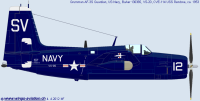


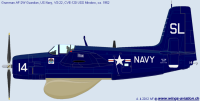


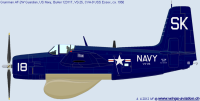
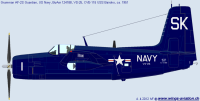


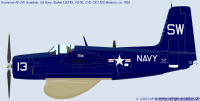
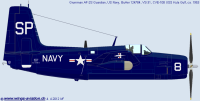






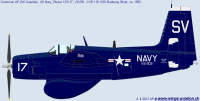

Test an Evaluation Squadrons

Naval Reserve













| Specifications |
AF-2S |
|
|
Wingspan |
Spannweite |
18,49 m |
|
Length |
Länge |
13,21 m |
|
Height |
Höhe |
4,93 m |
|
Wing area |
Flügelfläche |
52,02 m² |
|
Engine |
Motor |
18-Zylinder-Sternmotor Pratt & Whitney R-2800-48W, 2420 PS |
|
Maximum speed |
Höchstgeschwindigkeit |
510 km/h |
|
Empty weight |
Leergewicht |
6'613 kg |
|
Loaded weight |
Startgewicht |
11'567 kg |
|
Climb Rate |
Steigrate |
9.4 m/s |
|
Service ceiling |
Gipfelhöhe |
9'905 m |
|
Range |
Reichweite |
2414 km |
|
Armament |
Bewaffnung |
907-kg-Torpedo / 2 907-kg-Bomben / 2 726-kg-Wasserbomben |
| Serial, Grumman AF- Guardian | ||
| XTB3F-1 | 90504 - 90506 | 2 |
| AD-2W / AD-2S | 123088 - 123117 | 30 |
| AD-2W / AD-2S | 124188 - 124209 | 22 |
| AD-2W / AD-2S | 124778 - 124849 | 72 |
| AF-2S | 126720 - 126737 | 18 |
| AF-2W | 126738 - 126755 | 18 |
| AF-2S | 126756 - 126821 | 66 |
| AF-2W | 126822 - 126835 | 14 |
| AF-2S | 129196 - 129242 | 47 |
| AF-2W | 129258 - 129299 | 104 |
| AF-3S | 129243 - 129257 | 15 |
| AF-3S | 130364 - 130388 | 25 |
| AF-2W | 130389 - 130404 | 16 |
|
Total |
449 |
|









